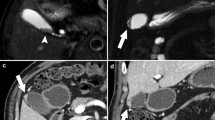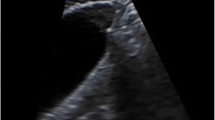ABSTRACT
Objectives
To determine the diagnostic value of the cotton ball sign and other CT features in patients with gallbladder (GB) wall thickenings (WTs).
Methods
Three blinded readers reviewed the preoperative CT and MR images of 101 patients with pathologically confirmed GB adenomyomatosis (GA) (n = 34) and other benign (n = 29), malignant (n = 41), and premalignant (n = 2) GBWTs. Three readers analysed the morphological features of GBWT and presence of the “cotton ball sign”, defined as fuzzy grey dots in GBWT or a dotted outer border of the inner enhancing layer on contrast-enhanced (CE) CT. In addition, the “pearl necklace sign” on MR was analysed.
Results
In the GA group (n = 34), prevalence of the cotton ball sign and pearl necklace sign was 74% (25/34) and 44% (15/34), respectively. Presence of the cotton ball sign, smooth contour of the mucosa, double-layering enhancement, and enhancement degree weaker than the renal cortex on CT images were significant predictors of benign GBWT (p < 0.01). When differentiating GA from GB malignancy or premalignancy, accuracy of the cotton ball sign and pearl necklace sign was 81% (62/77) and 74% (57/77), respectively.
Conclusion
The cotton ball sign on CE-CT showed higher sensitivity and comparable specificity to those of the pearl necklace sign in differentiating GA from malignancy.
Key Points
• Prevalence of the cotton ball sign on CT was 74% in gallbladder adenomyomatosis.
• The cotton ball sign was useful in differentiating gallbladder adenomyomatosis from gallbladder cancer.
• The cotton ball sign was more sensitive than the pearl necklace sign for adenomyomatosis diagnosis.





Similar content being viewed by others
Change history
04 July 2018
The original version of this article, published on 09 April 2018, unfortunately contained a mistake. The following correction has therefore been made in the original: The presentation of Fig. 2 was incorrect, “Cotton ball sign” was mistakenly named “Polka-dot sign”.
Abbreviations
- CE:
-
Contrast enhanced
- CT:
-
Computed tomography
- GA:
-
Gallbladder adenomyomatosis
- GB:
-
Gallbladder
- GBWT:
-
Gallbladder wall thickening
- GRE:
-
Gradient echo sequence
- HU:
-
Hounsfield unit
- MDCT:
-
Multi-detector computed tomography
- MRCP:
-
Magnetic resonance cholangiopancreatography
- MRI:
-
Magnetic resonance imaging
- PVP:
-
Portal venous phase
- RAS:
-
Rokitansky-Aschoff sinus
- US:
-
Ultrasound
References
Kim SJ, Lee JM, Lee JY et al (2008) Analysis of enhancement pattern of flat gallbladder wall thickening on MDCT to differentiate gallbladder cancer from cholecystitis. AJR Am J Roentgenol 191:765–771
Bonatti M, Vezzali N, Lombardo F et al (2017) Gallbladder adenomyomatosis: imaging findings, tricks and pitfalls. Insights Imaging 8:243–253
Hammad AY, Miura JT, Turaga KK, Johnston FM, Hohenwalter MD, Gamblin TC (2016) A literature review of radiological findings to guide the diagnosis of gallbladder adenomyomatosis. HPB (Oxford) 18:129–135
Kim JH, Jeong IH, Han JH et al (2010) Clinical/pathological analysis of gallbladder adenomyomatosis; type and pathogenesis. Hepatogastroenterology 57:420–425
Cariati A, Cetta F (2003) Rokitansky-Aschoff sinuses of the gallbladder are associated with black pigment gallstone formation: a scanning electron microscopy study. Ultrastruct Pathol 27:265–270
Mariani PJ, Hsue A (2011) Adenomyomatosis of the gallbladder: the "good omen" comet. J Emerg Med 40:415–418
Joo I, Lee JY, Kim JH et al (2013) Differentiation of adenomyomatosis of the gallbladder from early-stage, wall-thickening-type gallbladder cancer using high-resolution ultrasound. Eur Radiol 23:730–738
Chantarojanasiri T, Hirooka Y, Kawashima H, Ohno E, Kongkam P, Goto H (2017) The role of endoscopic ultrasound in the diagnosis of gallbladder diseases. J Med Ultrason (2001) 44:63–70
Ching BH, Yeh BM, Westphalen AC, Joe BN, Qayyum A, Coakley FV (2007) CT differentiation of adenomyomatosis and gallbladder cancer. AJR Am J Roentgenol 189:62–66
Yoshimitsu K, Honda H, Jimi M et al (1999) MR diagnosis of adenomyomatosis of the gallbladder and differentiation from gallbladder carcinoma: importance of showing Rokitansky-Aschoff sinuses. AJR Am J Roentgenol 172:1535–1540
Haradome H, Ichikawa T, Sou H et al (2003) The pearl necklace sign: an imaging sign of adenomyomatosis of the gallbladder at MR cholangiopancreatography. Radiology 227:80–88
Mirbagheri SA, Mohamadnejad M, Nasiri J, Vahid AA, Ghadimi R, Malekzadeh R (2005) Prospective evaluation of endoscopic ultrasonography in the diagnosis of biliary microlithiasis in patients with normal transabdominal ultrasonography. J Gastrointest Surg 9:961–964
Imazu H, Mori N, Kanazawa K et al (2014) Contrast-enhanced harmonic endoscopic ultrasonography in the differential diagnosis of gallbladder wall thickening. Dig Dis Sci 59:1909–1916
Miyazaki T, Yamashita Y, Tsuchigame T, Yamamoto H, Urata J, Takahashi M (1996) MR cholangiopancreatography using HASTE (half-Fourier acquisition single-shot turbo spin-echo) sequences. AJR Am J Roentgenol 166:1297–1303
Hwang JI, Chou YH, Tsay SH et al (1998) Radiologic and pathologic correlation of adenomyomatosis of the gallbladder. Abdom Imaging 23:73–77
Clouston JE, Thorpe RJ (1991) Case report--CT findings in adenomyomatosis of the gallbladder. Australas Radiol 35:86–87
Chao C, Hsiao HC, Wu CS, Wang KC (1992) Computed tomographic finding in adenomyomatosis of the gallbladder. J Formos Med Assoc 91:467–469
Stunell H, Buckley O, Geoghegan T, O'Brien J, Ward E, Torreggiani W (2008) Imaging of adenomyomatosis of the gall bladder. J Med Imaging Radiat Oncol 52:109–117
Altman DG (1990) Practical statistics for medical research. CRC press
van Breda Vriesman AC, Engelbrecht MR, Smithuis RH, Puylaert JB (2007) Diffuse gallbladder wall thickening: differential diagnosis. AJR Am J Roentgenol 188:495–501
Levy AD, Murakata LA, Rohrmann CA Jr (2001) Gallbladder carcinoma: radiologic-pathologic correlation. Radiographics 21:295–314 questionnaire, 549-255
Baron RL (1991) Computed tomography of the biliary tree. Radiol Clin North Am 29:1235–1250
Zissin R, Osadchy A, Shapiro-Feinberg M, Gayer G (2003) CT of a thickened-wall gall bladder. Br J Radiol 76:137–143
Westra WH (2003) Surgical pathology dissection: an illustrated guide, 2nd edn. Springer, New York
Bang SH, Lee JY, Woo H et al (2014) Differentiating between adenomyomatosis and gallbladder cancer: revisiting a comparative study of high-resolution ultrasound, multidetector CT, and MR imaging. Korean J Radiol 15:226–234
Adusumilli S, Siegelman ES (2002) MR imaging of the gallbladder. Magn Reson Imaging Clin N Am 10:165–184
Imai H, Osada S, Sasaki Y et al (2011) Gallbladder adenocarcinoma with extended intramural spread in adenomyomatosis of the gallbladder with the pearl necklace sign. Am Surg 77:E57–E58
Yoshimitsu K, Irie H, Aibe H et al (2005) Well-differentiated adenocarcinoma of the gallbladder with intratumoral cystic components due to abundant mucin production: a mimicker of adenomyomatosis. Eur Radiol 15:229–233
Rice J, Sauerbrei EE, Semogas P, Cooperberg PL, Burhenne HJ (1981) Sonographic appearance of adenomyomatosis of the gallbladder. J Clin Ultrasound 9:336–337
Raghavendra BN, Subramanyam BR, Balthazar EJ, Horii SC, Megibow AJ, Hilton S (1983) Sonography of adenomyomatosis of the gallbladder: radiologic-pathologic correlation. Radiology 146:747–752
Brambs HJ, Wrazidlo W, Schilling H (1990) The sonographic image of gallbladder adenomyomatosis. Rofo 153:633–636
Boscak AR, Al-Hawary M, Ramsburgh SR (2006) Best cases from the AFIP: Adenomyomatosis of the gallbladder. Radiographics 26:941–946
Funding
The authors state that this work has not received any funding.
Author information
Authors and Affiliations
Corresponding author
Ethics declarations
Guarantor
The scientific guarantor of this publication is Jeong Min Lee.
Conflict of interest
The authors of this manuscript declare no relationships with any companies, whose products or services may be related to the subject matter of the article.
Statistics and biometry
No complex statistical methods were necessary for this paper.
Informed consent
Written informed consent was waived by the Institutional Review Board.
Ethical approval
Institutional Review Board approval was obtained.
Methodology
• retrospective
• diagnostic or prognostic study
• performed at one institution
Electronic supplementary material
ESM 1
(DOCX 28 kb)
Rights and permissions
About this article
Cite this article
Yang, H.K., Lee, J.M., Yu, M.H. et al. CT diagnosis of gallbladder adenomyomatosis: importance of enhancing mucosal epithelium, the “cotton ball sign”. Eur Radiol 28, 3573–3582 (2018). https://doi.org/10.1007/s00330-018-5412-4
Received:
Revised:
Accepted:
Published:
Issue Date:
DOI: https://doi.org/10.1007/s00330-018-5412-4




